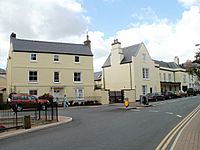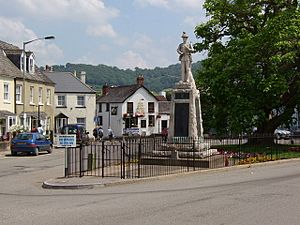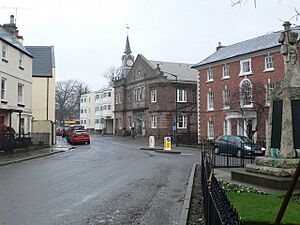33 Whitecross Street, Monmouth facts for kids
Quick facts for kids 33 Whitecross Street |
|
|---|---|

33 Whitecross Street, to left,
at southwest side of St James Square |
|
| Alternative names | 33 St James Square |
| General information | |
| Status | Grade II listed |
| Location | Whitecross Street at St James Square, Monmouth, Monmouthshire, Wales |
| Coordinates | 51°48′47″N 2°42′41″W / 51.8130°N 2.7115°W |
33 Whitecross Street is an old and important building in Monmouth, Monmouthshire, Wales. It is officially a Grade II listed building, meaning it's protected because of its special history and design. You can find it in the historic St James Square area.
In 2009, archaeologists dug at this spot. They found amazing clues about people who lived here long ago. They discovered signs from the Neolithic (prehistoric Stone Age), Roman times, and the Middle Ages. A year later, more digging nearby in the square found even older evidence. It was the first time anyone found proof of Mesolithic human settlement (Middle Stone Age) in Monmouth!
St James Square: A Special Place

St James Square in Monmouth is a truly lovely spot. A newspaper, The Telegraph, described it in 2006 as one of the prettiest places in town. It has an old Monmouth War Memorial and a beautiful, "romantic-looking" tree.
The War Memorial was put in the square in 1921. It was created by a sculptor named W. Clarke. 33 Whitecross Street is located right where Whitecross Street ends, next to the roundabout that goes around the triangular St James Square. Sometimes, the building is also called 33 St James Square.
The "romantic-looking tree" is a special Catalpa or Indian Bean Tree. It was planted around 1900. People think it's one of the best examples of its kind in Britain! In 2005, there was a bit of a fuss when the local council thought about removing the tree, but it's still there today.
About the Building
33 Whitecross Street was officially listed as a Grade II building on August 15, 1974. This means it's an important historical building.
It's a three-storey house with its main door in the middle. The front porch has a door with six panels and thin cast iron columns on each side. To the right of the door, there's a special bay window that sticks out, added around the year 1900. All the windows on the front of the house are made of large, single panes of glass. The windows on the top floor are a bit smaller.
The roof is made of Welsh slate. The back of the house has a very steep roof and is only two storeys tall. You can see two chimneys made of red brick. The outside walls are painted and have a rough finish. They also have two decorative band courses, which are like horizontal stripes. The building was listed because of its "special architectural interest" and because it's in an area with many other historic buildings. Experts believe this house was probably built in the 1700s.
Digging Up History
In January 2009, the Monmouthshire County Council announced that they had approved plans for two new additions to the back of 33 Whitecross Street. Because the building is so old and important, they said that archaeologists would need to watch the digging very carefully.
This archaeological work was done by a company called Monmouth Archaeology in July 2009. They wrote a report about what they found on August 13, 2009. The team included archaeologists like Stephen Clarke, Jane Bray, Dave Hancocks, and Colin Harris.
Their findings were exciting! They concluded that there was evidence of activity from many different time periods at 33 Whitecross Street. They found signs from:
- The prehistoric Neolithic period (New Stone Age)
- The Roman period
- The Medieval period (Middle Ages)
- The Post-Medieval period (after the Middle Ages)
The next year, in November 2010, the BBC News reported even more amazing news. A team of local archaeologists had found Mesolithic (Middle Stone Age) tools and items in St James Square and Wyebridge Street, very close by. This discovery was incredibly important because it was the first time anyone found proof of human settlement in Monmouth from the Mesolithic period. It showed that people lived in this area much, much longer ago than previously thought!


